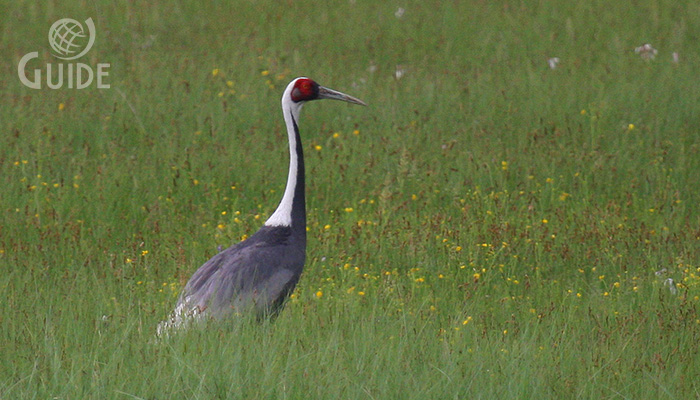
English: White-naped Crane
Russian: Даурский журавль
German: Weissnackenkranich
French: Grue a cou blanc
Mongolian: Цэн тогоруу
Japanese: マナヅル (Mana-zuru)
Body length: 120-153 cm
Wing span: 200-210 cm
Passage migrant
Breeding season: May-August
Egg number: 1-2
Egg colour: Greenish yellow
with dark or bluish-brown spots.
Brood: 1 per year
Food: Insects. Invertebrates,
amphibians, seeds, roots and wetland plants.
Status: Very rare species. According to the IUCN Red List categories andcriteria,
the species evaluated as-Vulnerable.
Distribution and Range: Few pairs are recorded in the North-eastern China, western edge
of China, western edge of Chita region, Amur River valley in Russia. Winters in
Korea, China and Japan. In Mongolia: The Onon, Kherlen, Ulz, Bagttakh, Nomrog,
Kharaa and Buur River valleys and their tributiaries, the esturaries of the
Tuul and Kharvakh Rivers, Aikhan Lake in Bulgan Aimag, Khar Us Lakes and
Avdrant Mountain in Khovd Aimag.
Habitat: Breeds on the steppe, meadows, rivers valleys and lakes with reed
population.
Population and threats: Global population of Japanese White-naped Crane is estimated at
2.5-3 thousand individuals 189 were reported along the Ulz River in 1990, end
July; in April 1991-51 along the Sumyin Tsagaan Lake in the Kherlen Soum; in end
July, beginning of August 1992-161 in the Ulz and Yamalkh Rivers; in August
1993-20 along the Kherlen River to Choibalsan; in end April, beginning of May
1994-191 along the Khurkh River, Binder and Tsegeen lakes, the Onon and Barkh
tributaries, the Shuuz, Ulz, Doch and Yamalkh Rivers; in end July, beginning of
August 1994-246 adults and 26 fledgelings along the Onon and Ulz Rivers. In September
1994, 2.5-3 thousands migrating White-naped and Hooded Cranes flocks were
recorded in the Ulz River Basin. Approximately 800 individuals breed in
Mongolia. In recent years, breeding range for this birds spread to northwest to
the shore of the Aikhan, Teshigiin Olon, Tarvagtai and Khujiriin Lakes. 36
cranes were sighted in September 2013 in the Aikhan lake valley. Steppe fires
and floods threaten nests, eggs and juveniles as well as predation by wolves,
dogs, Alpine Weasels, eagles, Hooded Crows and Northern Ravens.
Conservation Measures: Listed as Rare in the Mongolian Government resolution #164 (2001),
included in the CITES Annex I and CMS Annex II, the Mongolian Red Book
(1987,1997), and the Asia Red Data Book
for Birds (2001). Certain parts of the habitat area was included within the
NSPAN. The WWF and Local government organizations jointly organized conservation
activities and surveys on Onon and Ulz Rivers involving the local residents.
Further actions: Included in the list of very rare animals, improve conservation
measures on habitat area, reduce disturbances by people and livestock in the
breeding areas, conduct public awareness program.